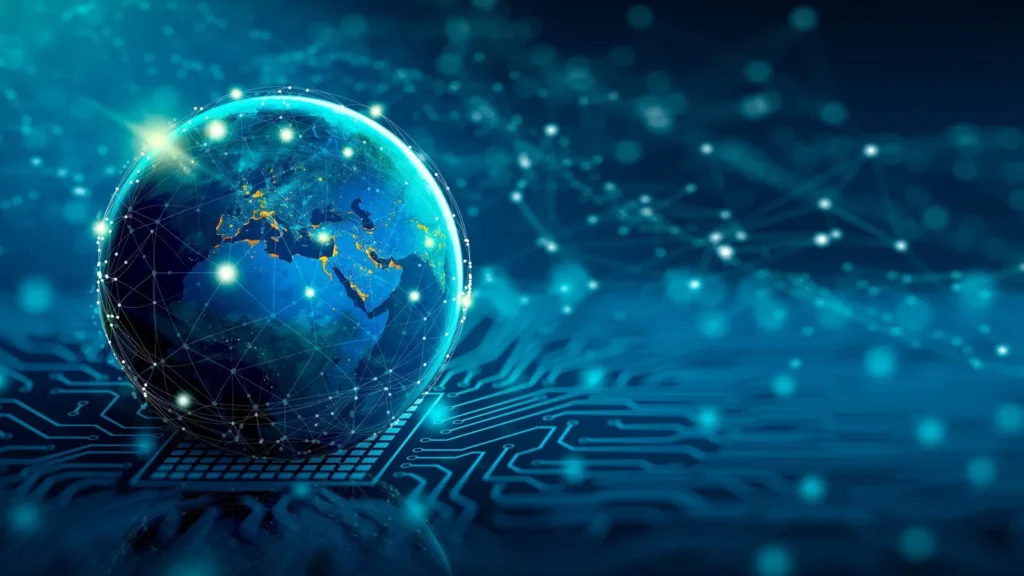
The Future of World Technology: A Deep Dive into Emerging Innovations
As we stand at the cusp of a new technological era, humanity is experiencing an unprecedented transformation driven by breakthroughs across a wide range of disciplines. From artificial intelligence and quantum computing to bioengineering and space exploration, future technologies are not only reshaping industries but also redefining the very nature of our existence. This article explores some of the most promising and potentially disruptive future technologies, delving into their implications, applications, and ethical challenges.
1. Quantum Computing and the Quantum Internet
The Next Frontier of Computing
Quantum computing is poised to revolutionize the way we process information. Unlike classical computers that use bits (0s and 1s), quantum computers use qubits, which can exist in multiple states simultaneously, thanks to the principles of quantum superposition. This capability allows quantum computers to perform complex calculations at speeds unimaginable with today’s fastest supercomputers.
Current Progress: Companies like IBM, Google, and Intel are making significant strides in developing quantum computers. Google’s quantum processor, Sycamore, demonstrated “quantum supremacy” in 2019 by solving a problem in minutes that would take classical computers thousands of years. Though we’re still in the early stages, this technology holds the potential to solve problems in drug discovery, cryptography, material science, and artificial intelligence that are currently unsolvable.
The Quantum Internet
Parallel to the development of quantum computers is the concept of a quantum internet. This network would allow for ultra-secure communication through quantum entanglement, where particles share information instantaneously, regardless of distance. Theoretically, this system would be immune to traditional hacking methods, providing an unhackable communication medium.
Impact and Applications: Quantum computing could break current encryption methods, raising concerns about data security. However, the quantum internet could also create the foundation for secure global communications in sectors like finance, defense, and governance. Moreover, breakthroughs in quantum machine learning could lead to AI systems far beyond current capabilities, potentially creating self-learning systems that evolve without human intervention.
2. Artificial Intelligence: The Rise of Superintelligence
AI Evolution
Artificial Intelligence (AI) has advanced exponentially in recent years, transitioning from simple algorithms to deep learning models capable of complex reasoning and decision-making. While current AI, like OpenAI’s GPT models, excels in language understanding and generation, future iterations are expected to possess general intelligence—the ability to perform any intellectual task that a human can do, and beyond.
Key Developments:
- Neural Networks: Deep learning networks that mimic the brain’s structure, capable of recognizing patterns and learning from vast datasets.
- Reinforcement Learning: AI systems that learn by interacting with their environment and receiving feedback, allowing them to master complex tasks such as gaming or robotics.
- Generative AI: Models that can create new data, such as text, images, or music, opening up new possibilities in creative industries and content generation.
AI-Driven Personal Assistants 2.0
Future AI systems will go beyond simple voice commands and scheduling. AI-driven personal assistants will have the capacity to understand individual preferences, anticipate needs, and even make complex decisions. These assistants will become integral to both personal and professional life, performing tasks like drafting legal documents, diagnosing medical conditions, or managing entire businesses autonomously.
Challenges and Ethical Questions: As AI systems become more autonomous, concerns arise about job displacement, bias in decision-making, and the potential misuse of AI in surveillance or warfare. The development of AI ethics and regulatory frameworks will be crucial to ensure that AI benefits society without infringing on human rights or exacerbating inequalities.
3. Autonomous Smart Cities
The Integration of AI and IoT
Autonomous smart cities represent the fusion of AI, the Internet of Things (IoT), and automation to create highly efficient urban environments. In these cities, everything from transportation and energy management to waste disposal and public safety will be controlled by interconnected systems. AI algorithms will optimize traffic flow, reducing congestion and accidents, while smart grids will balance energy loads to ensure sustainability.
Key Features:
- Self-Driving Infrastructure: Autonomous vehicles will dominate public and private transportation, reducing accidents and making commutes more efficient.
- Smart Buildings: Homes and offices will adjust lighting, temperature, and energy consumption based on real-time data, contributing to sustainability.
- Drone Deliveries: Delivery drones and robots will replace traditional logistics systems, reducing the environmental impact and improving delivery times.
Sustainable and Eco-Friendly
Smart cities will also prioritize sustainability. They will leverage renewable energy sources like solar and wind, and use AI to manage resources efficiently. For example, smart waste disposal systems will automatically sort and recycle materials, drastically reducing waste production.
Challenges: The creation of autonomous smart cities will require significant infrastructure investments and cooperation between governments, private companies, and tech innovators. Privacy concerns will also be a major issue, as the collection and analysis of massive amounts of personal data will be central to the functionality of these cities.
4. Personal Health Nanobots: A New Era of Medicine
Nanotechnology in Healthcare
Imagine a world where tiny robots, known as nanobots, patrol your bloodstream, constantly monitoring your health and fighting diseases before symptoms even appear. This is not science fiction—advances in nanotechnology could make this a reality within the next few decades.
Key Applications:
- Early Disease Detection: Nanobots can detect minute changes in body chemistry, identifying diseases such as cancer at their earliest stages.
- Targeted Drug Delivery: Instead of systemic treatments like chemotherapy, nanobots could deliver drugs directly to affected cells, reducing side effects and improving efficacy.
- Tissue Repair and Regeneration: Nanobots could help heal damaged tissues, possibly even reversing the effects of aging and injuries.
Ethical and Societal Implications
While personal health nanobots could drastically improve healthcare outcomes and extend lifespans, they raise profound ethical questions. Who will have access to this technology? Could it lead to biological inequality, where only the wealthy can afford these advanced treatments? Regulatory bodies will need to establish guidelines to ensure equitable access and prevent misuse.
5. Sustainable Fusion Energy: Powering the Future
The Quest for Clean, Unlimited Energy
One of the greatest challenges of the 21st century is finding a sustainable, environmentally friendly energy source. Nuclear fusion— the process that powers the sun—offers the promise of limitless, clean energy. Unlike nuclear fission, which produces radioactive waste, fusion combines light atomic nuclei to form heavier ones, releasing vast amounts of energy in the process.
Current Progress:
- The International Thermonuclear Experimental Reactor (ITER), an international collaboration, aims to demonstrate the feasibility of fusion as a large-scale, carbon-free energy source.
- Advances in superconducting magnets and plasma confinement are bringing us closer to achieving a “net energy gain,” where the energy produced exceeds the energy required to sustain the reaction.
Impact on Global Energy Systems
Once achieved, fusion energy could replace fossil fuels entirely, providing a nearly limitless energy supply with minimal environmental impact. This could be the key to solving the global climate crisis, reducing reliance on polluting energy sources, and making energy more accessible to developing nations.
Challenges: Despite progress, commercial fusion energy remains decades away. The immense technical challenges and high costs of developing fusion reactors will require sustained investment and global cooperation.
6. Digital Immortality and Consciousness Uploading
The Future of Human Life
One of the most radical technological concepts is digital immortality—the idea of uploading human consciousness into a digital or robotic form. Advances in neuroscience, AI, and brain-computer interfaces (BCIs) are making it possible to map and replicate the human brain digitally.
Key Applications:
- Mind Uploading: People could potentially transfer their consciousness to a digital format, existing in virtual environments or robotic bodies.
- Cognitive Enhancement: BCIs could enhance human cognitive abilities, improving memory, creativity, and processing power.
Ethical Considerations
Digital immortality raises profound ethical and philosophical questions. What does it mean to be human? If a person’s consciousness is uploaded, is that person still alive? Could this technology create a divide between those who choose immortality and those who remain in physical bodies? These questions will need to be addressed as technology advances.
7. 3D Printed Habitat Construction and Space Colonization
Building on Earth—and Beyond
3D printing is evolving rapidly, and one of its most exciting applications is in construction. Large-scale 3D printers can build houses and infrastructure using sustainable, local materials in a fraction of the time and cost of traditional construction methods.
Key Applications:
- Affordable Housing: 3D-printed homes can help alleviate housing shortages, particularly in developing countries or disaster-stricken areas.
- Space Colonization: NASA and private companies like SpaceX are exploring the use of 3D printing to build habitats on the Moon or Mars, using materials available on-site to reduce the cost of transporting construction materials from Earth.
Impact: 3D-printed habitats could solve housing crises on Earth while enabling humans to colonize other planets, bringing us closer to becoming an interplanetary species.
Conclusion
The future of technology promises to be both exhilarating and challenging. While advancements in AI, quantum computing, nanotechnology, and renewable energy have the potential to solve many of the world’s greatest problems, they also introduce new ethical dilemmas and societal disruptions. Balancing innovation with ethical considerations will be key to ensuring that these technologies benefit all of humanity.
As we look to the future, it’s clear that technology will not only shape our industries and economies but also redefine what it means to be human. Whether through quantum leaps in computing, life-extending medical breakthroughs, or the colonization of other planets, the future of world technology is limited only by our imagination.
Let’s expand further on the future of world technology by delving into additional areas that will likely play transformative roles in shaping society. We’ll look at advances in genetic engineering, human-machine interfaces, biotechnology, advanced space exploration, virtual reality (VR), cybersecurity challenges, and ethical AI governance. Each of these domains promises to revolutionize life as we know it, influencing everything from our biology to the way we work, interact, and explore the universe.
8. Advanced Genetic Engineering and CRISPR 2.0
Redefining Biological Possibilities
Genetic engineering has already seen a massive leap forward with the introduction of CRISPR-Cas9, a genome-editing tool that allows scientists to modify DNA with unprecedented precision. CRISPR 2.0, and subsequent gene-editing technologies, promise to refine this process even further, enabling not only the treatment of inherited diseases but also the enhancement of human physical and cognitive abilities.
Applications:
- Gene Therapy: The use of CRISPR to correct mutations in the human genome can treat a range of conditions, including cancer, muscular dystrophy, and cystic fibrosis.
- Genetic Enhancement: Beyond treatment, CRISPR could be used for human augmentation, improving traits such as intelligence, strength, or resistance to diseases.
- Agricultural Innovation: Genetically modified crops with built-in resistance to pests, extreme weather, or diseases could revolutionize food production, addressing hunger and malnutrition on a global scale.
Ethical Dilemmas and Genetic Inequality
The potential for genetic engineering to enhance humans opens a Pandora’s box of ethical issues. Should we edit human embryos to remove the risk of disease? What about enhancing traits like intelligence or athletic ability? There’s the danger that genetic inequality could arise, where wealthier individuals have access to genetic enhancements, creating a biologically superior class of humans. The governance and regulation of this technology will be crucial to ensuring it is used ethically and equitably.
9. Human-Machine Interfaces (BCIs and Neural Implants)
Bridging the Gap Between Human and Machine
Brain-computer interfaces (BCIs) are rapidly advancing, allowing humans to interact directly with computers using their thoughts. Companies like Neuralink, founded by Elon Musk, are developing neural implants that can read brain signals and transmit them to external devices. These technologies could radically alter how we interact with machines and even enhance our mental and physical capabilities.
Key Applications:
- Neural Prosthetics: BCIs can restore function to individuals with disabilities by enabling them to control robotic limbs or communicate via computers without using their physical bodies.
- Cognitive Enhancement: Neural implants could enhance memory, attention, and processing speed, potentially leading to superhuman cognitive abilities.
- Direct Brain-to-Brain Communication: In the future, BCIs may enable direct communication between human minds, allowing people to share thoughts and experiences instantaneously, revolutionizing the way we connect and communicate.
Challenges and Concerns
While BCIs offer incredible possibilities, they also raise significant concerns. Privacy will become a major issue—if your thoughts can be read or even influenced by external systems, how do we protect the integrity of the human mind? Moreover, the ethical boundaries of cognitive enhancement and brain augmentation will need to be explored, as we approach an era where the line between human and machine begins to blur.
10. Biotechnology and Synthetic Biology
Engineering Life Itself
Biotechnology, particularly synthetic biology, aims to create or redesign biological organisms to have new, beneficial traits. Synthetic biology could enable the production of biofuels, new medicines, and biodegradable materials, as well as the creation of bioengineered organs for transplantation.
Key Innovations:
- Organ Regeneration: Scientists are working on bioprinting and growing human organs in labs, addressing the global shortage of transplant organs.
- Bio-Manufacturing: Using engineered organisms to produce pharmaceuticals, chemicals, and even food, reducing the need for traditional manufacturing processes that are energy-intensive or harmful to the environment.
- Designer Microorganisms: Synthetic biologists are creating custom microorganisms that can clean up oil spills, purify water, or sequester carbon dioxide, aiding in the fight against environmental degradation.
Bioethical Considerations
As biotechnology advances, it will be critical to consider the ethical implications of creating and modifying life. The use of synthetic organisms in the environment, or the creation of bioengineered species, could have unforeseen consequences on ecosystems. Moreover, biohacking—where individuals experiment with biological augmentation outside of regulated scientific institutions—could lead to dangerous, unintended outcomes.
11. Space Exploration and Advanced Propulsion Systems
The Era of Interplanetary Travel
Space exploration is entering a new golden age, driven by both governmental agencies like NASA and private companies like SpaceX, Blue Origin, and others. The development of advanced propulsion systems—such as ion thrusters, nuclear fusion drives, and solar sails—could make long-distance space travel feasible, bringing Mars, the outer planets, and even interstellar exploration within reach.
Major Developments:
- Mars Colonization: SpaceX is working on making human colonization of Mars possible by the mid-2030s. Advanced life-support systems, 3D-printed habitats, and sustainable agriculture in space are some of the key technologies being developed to support life on other planets.
- Asteroid Mining: Companies are also eyeing space as a source of raw materials. Asteroid mining could provide rare minerals and metals, creating a new space economy and reducing the need for resource extraction on Earth.
- Interstellar Probes: Projects like Breakthrough Starshot aim to develop tiny, high-speed probes capable of reaching neighboring star systems within a few decades, offering the possibility of discovering life on other planets.
The Ethical Frontier
Space colonization and resource exploitation bring up important ethical issues. How do we prevent the commercialization of space from becoming another frontier for inequality and exploitation? Should humanity have the right to terraform and colonize other planets, potentially disrupting extraterrestrial ecosystems? These are some of the pressing questions that will accompany the rapid expansion of human presence in space.
12. Virtual Reality (VR) and Augmented Reality (AR)
Beyond Entertainment: A New Reality
While VR and AR are currently associated with entertainment and gaming, their future applications are far more profound. Immersive virtual environments will transform everything from education and training to healthcare and social interactions, blurring the lines between the physical and digital worlds.
Applications in the Near Future:
- Education and Training: VR will provide immersive learning experiences, allowing students to explore historical events, conduct virtual chemistry experiments, or practice surgery in simulated environments.
- Therapy and Mental Health: VR has already been used to treat conditions like PTSD and anxiety, and future applications could include fully immersive environments for behavioral therapy, mental health support, or even pain management.
- Workplace Collaboration: As remote work becomes more common, AR and VR can create virtual offices where teams can collaborate in a shared space, regardless of physical location.
Societal and Psychological Effects
While VR offers exciting possibilities, there are concerns about its impact on mental health and social behavior. Prolonged immersion in virtual worlds may lead to addiction, disassociation, or a preference for virtual interactions over real-life experiences. Society will need to navigate the psychological effects of spending more time in digital spaces, balancing the benefits of VR with the potential for isolation.
13. Cybersecurity in the Age of Hyperconnectivity
Securing the Digital World
As technology becomes more pervasive and interconnected, the risks associated with cyberattacks and data breaches increase. Cybersecurity will need to evolve rapidly to protect against increasingly sophisticated threats, particularly as quantum computing and AI become tools for both defense and attack.
Key Cybersecurity Innovations:
- Quantum Encryption: Quantum-based encryption methods will be necessary to protect data in a world where quantum computers can break traditional cryptographic algorithms.
- AI-Driven Defense Systems: AI will be used to detect and respond to cyber threats in real-time, preventing breaches before they occur. This technology could identify vulnerabilities and adapt to new attack strategies on the fly.
- Zero-Trust Security Models: This approach assumes that no system or user can be trusted by default, requiring continuous verification of identities and data access across all levels of a network.
The Ethical Dilemma of Surveillance
As cybersecurity becomes more advanced, there is a growing concern about mass surveillance. How do we balance the need for security with the protection of individual privacy? Governments and corporations are collecting more data than ever before, often without the knowledge or consent of the individuals involved. Striking a balance between security and privacy will be one of the most critical challenges of the digital age.
14. Ethical AI Governance
The Need for Regulation and Control
As AI systems become more autonomous and integrated into critical infrastructure, the need for governance becomes apparent. The potential for AI misuse—whether in biased decision-making, autonomous weapons, or surveillance—requires the establishment of clear ethical guidelines and regulations.
Key Areas of Focus:
- AI Transparency: AI systems need to be explainable and transparent in their decision-making processes to prevent misuse and bias.
- Human-AI Collaboration: Instead of AI replacing human roles, the focus should be on enhancing human capabilities through collaboration with AI systems.
- AI Accountability: Who is responsible when an AI system makes a mistake? Establishing accountability in the development and deployment of AI will be crucial to ensuring that these systems are used responsibly.
Global Collaboration
Given the global nature of AI development, international cooperation will
be essential. The creation of AI governance bodies that oversee ethical AI use and regulate the deployment of potentially harmful technologies, like autonomous weapons or mass surveillance tools, is likely to be a priority in the coming decades.
Conclusion: The Promise and Peril of Future Technology
The technologies of the future promise to solve some of the most pressing challenges facing humanity—curing diseases, reversing climate change, enabling space colonization, and enhancing human capabilities. However, they also pose new ethical, social, and environmental dilemmas that we must address proactively. The future of technology is a double-edged sword: it can elevate humanity to new heights, or it can exacerbate existing inequalities and create unforeseen risks.
As we look forward, the challenge will be to harness these transformative innovations in a way that benefits all of humanity while ensuring that the potential dangers are mitigated. By focusing on ethical governance, equitable access, and sustainable development, we can ensure that the future of technology leads to a brighter, more inclusive world.






